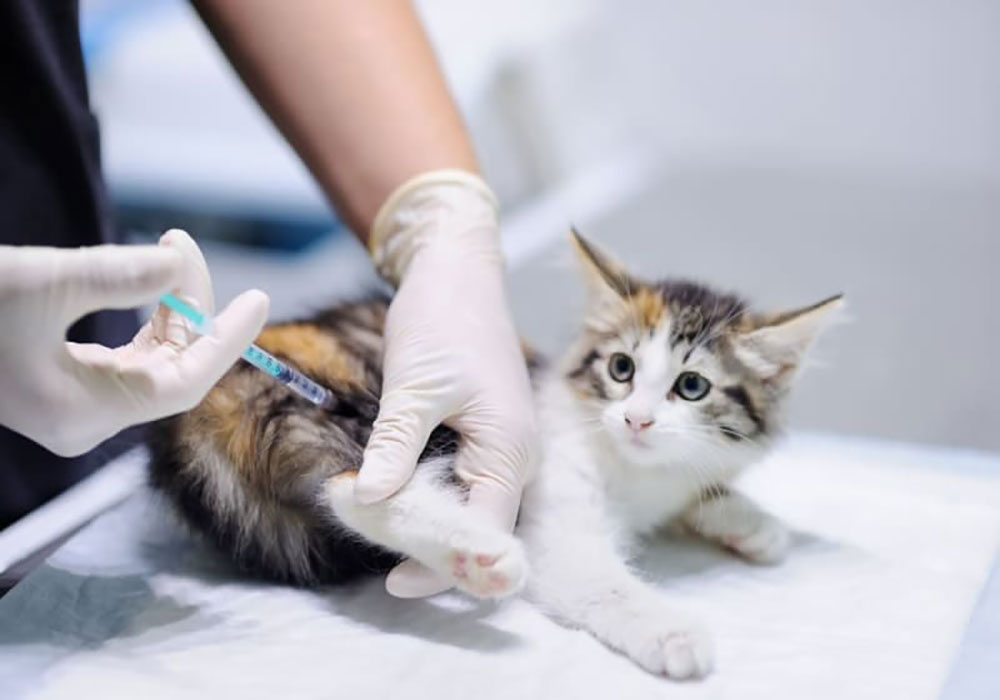Vaccinations are a crucial part of keeping your cat healthy and protected. In this guide, we’ll answer some common questions: What are vaccines? How do they work? Which ones does your cat need? And what should you expect after your cat is vaccinated?
Vaccinations are one of the most effective ways to protect your cat from serious, contagious diseases. By keeping your cat’s vaccines up to date, you ensure they stay healthy and safe for years to come. Be sure to discuss with your vet which vaccines are best suited to your cat’s lifestyle, and remember to keep an eye out for any unusual reactions after their shots.
What Are Cat Vaccines?
Vaccines, also known as immunizations or shots, help protect your cat from catching contagious diseases. They’re made from modified or killed versions of viruses or bacteria that won’t cause illness but are still able to trigger your cat’s immune system to fight off future infections.
Vaccines are usually given via an injection under the skin or, in some cases, through an intranasal spray (into the nose). These vaccines teach your cat’s immune system to recognize and fight off harmful agents, without causing illness. If your cat ever comes into contact with the actual disease, their immune system is ready to fight it off.
Vaccines are recommended for all cats—both indoor and outdoor—because they help prevent serious diseases. The American Association of Feline Practitioners (AAFP) sets guidelines on vaccinations for cats and regularly reviews the latest research.

Which Vaccines Do Cats Need?
Not all cats require the same vaccines. Some vaccines are considered “core” vaccines, which are recommended for every cat, whether they live indoors or outdoors. Others are “non-core” vaccines, recommended based on your cat’s lifestyle and risk level.
Core Vaccines For Cats
These vaccines are essential for all cats, regardless of whether they go outside:
Feline Panleukopenia (Feline Distemper or FPV): A potentially fatal disease that can affect the cat’s immune system and digestive system.
Feline Herpesvirus (Feline Viral Rhinotracheitis): A common respiratory virus causing sneezing, nasal discharge, and eye problems.
Feline Calicivirus (FCV): Another respiratory virus that can cause oral ulcers and pneumonia.
Rabies: A fatal disease that affects the brain and is a public health concern.
Feline Leukemia Virus (FeLV): Recommended for kittens under 1 year old, as they’re more vulnerable.
Fortunately, there is a combination vaccine (called FVRCP) that protects against rhinotracheitis, calicivirus, and panleukopenia in one shot. The FeLV vaccine is specifically recommended for kittens, who are more susceptible than adults.
Non-Core Vaccines
These vaccines are recommended based on your cat’s specific needs, environment, or risk exposure:
Feline Leukemia Virus (FeLV) – for cats older than 1 year (particularly if they go outside or live with other FeLV-positive cats).
Feline Immunodeficiency Virus (FIV): Not commonly used due to concerns about its effectiveness.
Bordetella Bronchiseptica (Kennel Cough): A bacteria causing respiratory issues, mostly for cats in shelters or boarding facilities.
Chlamydia Felis: A bacterial infection causing upper respiratory problems.
Feline Infectious Peritonitis (FIP): Although there is a vaccine, it’s not widely recommended.
Your vet will recommend which non-core vaccines your cat might need, based on their health, age, and lifestyle. For example, an indoor-only cat might not need the FeLV vaccine after a year.
What To Expect After Vaccinations
Once your cat gets their vaccines, they may feel a bit sore at the injection site for a few days—similar to how humans feel after getting a flu shot. Some cats might also feel a little sleepy or lazy, but this typically goes away by the next day.
Common Side Effects Of Cat Vaccines
While vaccines are generally very safe, there are some minor side effects you should be aware of:
Mild discomfort at the injection site;
A small lump or swelling where the vaccine was given;
A low fever (normal cat temperature is between 36.7°C and 38.9°C);
Lethargy or low energy;
Loss of appetite;
A runny nose or sneezing (especially after intranasal vaccines);
These side effects usually go away within a day or two and are nothing to worry about. However, it’s important to monitor your cat for any unusual reactions.
Serious Side Effects (Rare)
In very rare cases, your cat could have a more serious reaction to a vaccine. These include:
Anaphylaxis: A severe allergic reaction that can cause:
Hives (raised bumps);
Facial swelling;
Trouble breathing;
Vomiting or diarrhea;
Weakness or collapse
If your cat shows any of these signs within a few hours of getting vaccinated, contact your vet immediately or head to an emergency clinic.
Another rare but serious issue is Feline Injection-Site Sarcoma (FISS)—a cancerous tumor that can develop at the site of the injection. This occurs in about 1 in 10,000 to 30,000 cats, and while most lumps go away on their own, it’s important to let your vet know if you notice any bumps at the injection site.









